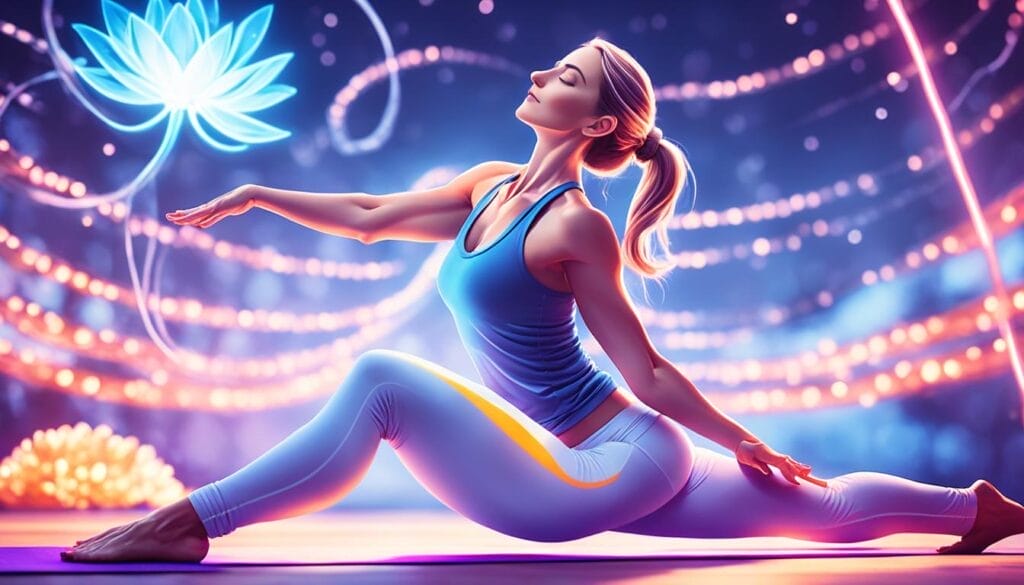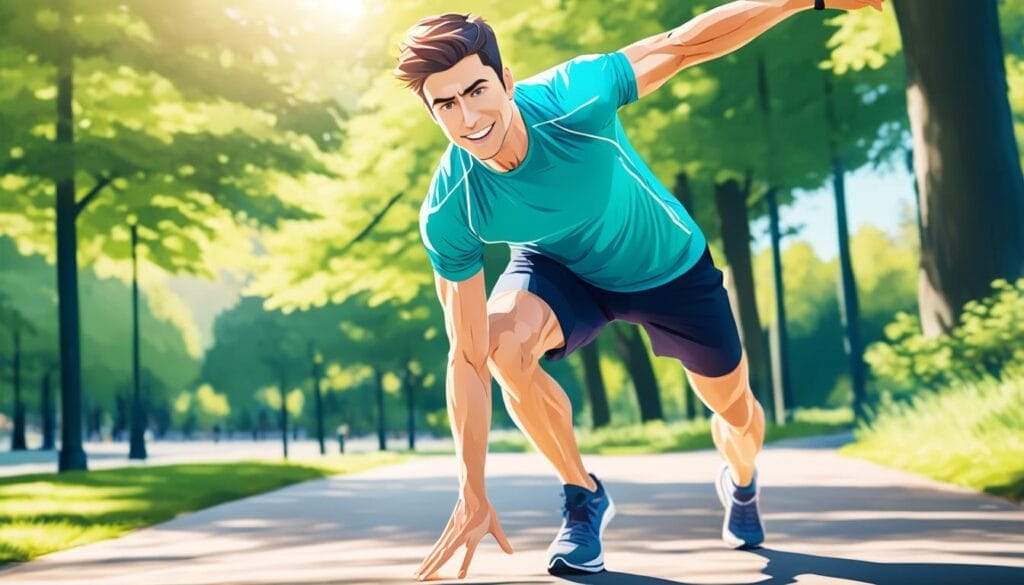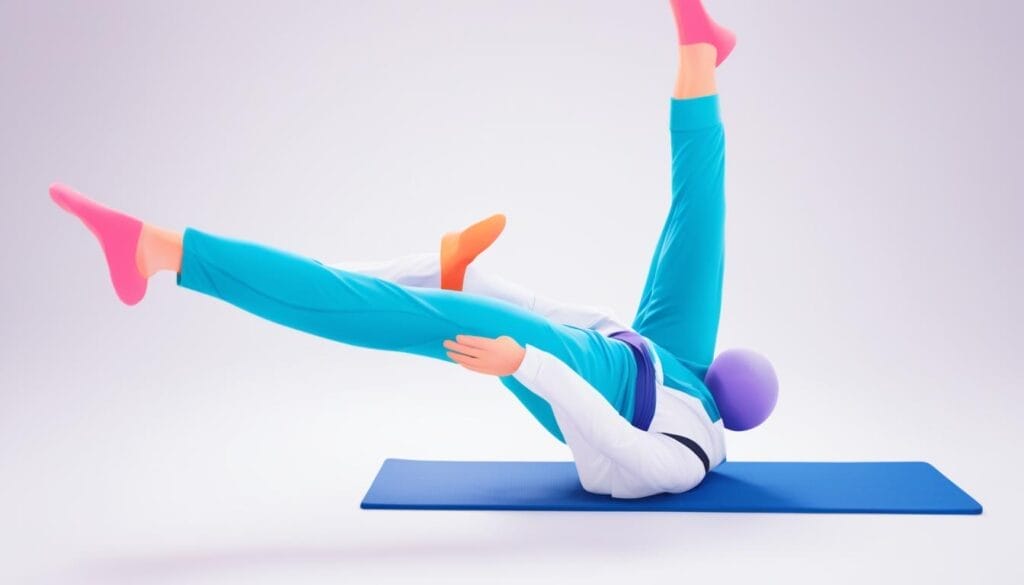Have you ever reached for something high and felt a muscle twinge? Or maybe you found touching your toes tricky? I sure have. These moments made me see how vital flexibility is every day. That’s when I turned to yoga. I wanted to see how it could make me more flexible.
Yoga is not just about stretching. It’s a whole approach that includes building strength safely and increasing body awareness. Many think you need to be super flexible to do yoga. But in reality, it helps you get more flexible with time. All you need is to keep at it.
Key Takeaways:
- Flexibility with yoga is a key component of physical fitness, and yoga can greatly improve it.
- Yoga promotes range of motion, joint health, and helps prevent pain and injuries.
- Flexibility is not a requirement to start practicing yoga, but it is a result of consistent practice over time.
- Yoga classes provide structured guidance and instruction to safely improve flexibility.
- By incorporating yoga into your routine, you can enhance your flexibility and experience the many benefits it offers for your body and mind.
Why Flexibility Is So Important
Flexibility is key to staying healthy and happy. It gives our body and mind many good things. It makes us move better, relaxes muscles, and keeps us from getting hurt.
But its effects are more than skin deep. Flexibility makes us less stressed and more relaxed. This is great for our mind. It helps get rid of stress, boosts blood flow, and makes us perform better physically and mentally.
Being flexible means moving easily every day. From picking up things to playing sports, it makes life fun. We get to do a lot more and feel free when our body can move any way we need.
Also, being flexible helps us stand and sit straight. It relaxes our muscles and makes our joints work better. This means less pain and aches, which is always good news.
“Flexibility is not just about physical health; it has a profound impact on our mental well-being as well. By reducing stress and promoting relaxation, flexibility contributes to a better overall quality of life.”
Flexibility is tied to our stress too. It helps turn off that feeling of being wound up. Activities like yoga or stretching are amazing for letting go of stress and feeling peaceful.
When we work on being flexible, we learn more about our own bodies. This is great for paying attention to what we need. It helps us chose ways to be our healthiest, both in body and spirit.
In the end, being flexible makes our lives better in many ways. It boosts how we move, cuts down on getting hurt, keeps our bodies in good shape. Plus, it helps make sure our daily life feels balanced and healthy.
So, let’s cheer for flexibility and find ways to make it part of how we live every day.
The Benefits of Flexibility
So, here are the main upsides of being flexible:
- Improved range of motion
- Reduced muscle tension
- Promotion of better posture
- Decreased pain and risk of injuries
- Reduced stress and enhanced relaxation
- Enhanced circulation
- Improved overall well-being
How Does Yoga Help Improve Flexibility?
Yoga is more than stretching; it’s a complete approach to flexibility. It teaches us about safe alignment and body awareness. This approach deeply impacts our flexibility.
Yoga uses specific poses to target muscles and improve joint health. It’s important to do poses correctly. This way, we prevent injuries and get the most from our practice.
Yoga uniquely focuses on paying attention to our body signals. This helps us understand our limits and ways to grow. Such awareness directly boosts our flexibility.
Yoga also impacts our mental health, lowering stress and anxiety. Tension from stress can make us less flexible. Regular yoga helps us relax and reduces this tension, making us more flexible.
Yoga expands our minds as it does our bodies, leading to peace and better flexibility.
The Mind-Body Connection and Flexibility
Being present mentally during yoga improves our flexibility. This focus lets us identify and work on tight areas. Yoga also teaches us how to be mindful, which boosts our body awareness and flexibility.
Adding yoga to your workout helps both the body and mind. It stretches and strengthens muscles, improves joint mobility, and promotes good posture. With time, we gain greater flexibility and movement.

Yoga Poses for Flexibility
| Yoga Pose | Targeted Muscles |
|---|---|
| Reclined Hand to Big Toe Pose (Supta Padangusthasana) | Hamstrings, hips, and calves |
| Eye of the Needle Pose (Sucirandhrasana) | Hips, glutes, and lower back |
| Downward Facing Dog (Adho Mukha Svanasana) | Hamstrings, shoulders, and calves |
| Crescent Lunge (Anjaneyasana) | Hip flexors, quadriceps, and ankles |
| Pyramid Pose (Parsvottanasana) | Hamstrings, hips, and calves |
These poses work on key muscle groups for flexibility. They can be adjusted for various levels of flexibility. Including them in your routine helps you become more flexible.
How Long Does it Take to Become More Flexible?
Improving flexibility through yoga varies for each person. How fast you get flexible relies on where you start, how often you do yoga, the kind of yoga, and your body. Getting more flexibility with yoga takes steady work over time.
Flexibility doesn’t come quickly. Being flexible means you need time, focus, and yoga. Some will see big changes in a few weeks, while others might take longer. Always remember, we’re all different, so results vary.
Yoga regularly, several times weekly, helps you maintain a constant routine. Your body adjusts slowly, getting more flexible over time. Don’t expect fast results. Enjoy the journey of becoming more flexible.
Never compare your flexibility journey with anyone else’s. What matters is your progress. Celebrate the small wins and love exploring what your body can do. This is about you and your growth.
Improving flexibility is as much about the journey as it is the goal. Yoga benefits your mind and body in incredible ways. Stick with it, and you’ll see the rewards.
Factors Affecting the Duration of Flexibility Improvement
Improving flexibility with yoga has several key points:
- Your starting flexibility matters. Those less flexible might need more time to improve.
- Yoga practice frequency is key to getting flexible faster. Practice regularly for better progress.
- Different yoga types impact flexibility growth differently. Styles like Yin yoga can help improve flexibility faster.
- Your body’s unique characteristics also play a role. Muscle tone and skeletal structure influence how you respond to yoga.
Understand these points and start a regular yoga habit to get more flexible. The journey is just as important as the goal. Every little progress is a step forward.
So, stick to regular yoga, enjoy the ride, and let your body naturally get more flexible through practice.
| Factors Affecting the Duration of Flexibility Improvement |
|---|
| The starting point |
| Frequency of practice |
| Type of yoga |
| Individual physique |
The Best Yoga Poses for Flexibility
Improving flexibility is crucial, and specific yoga poses can help a lot. They focus on key muscle groups like the hamstrings, hips, and shoulders. This improves your overall flexibility and how far you can move.
Let’s look at some top yoga poses that boost flexibility:
- Reclined Hand to Big Toe Pose (Supta Padangusthasana): This pose is great for the hamstrings and calves. It makes your legs more flexible. A strap or towel can be used if you’re not too flexible.
- Eye of the Needle Pose (Sucirandhrasana): It works on the hips and glutes. This helps release tension and make your hip more flexible. It’s especially good for those with tight hips.
- Downward Facing Dog (Adho Mukha Svanasana): This pose is famous for stretching the hamstrings, shoulders, and calves. It also lengthens the spine and makes you more aware of your body.
- Crescent Lunge (Anjaneyasana): It offers a deep stretch for your hip flexors and quadriceps. This increases flexibility in your hips and thighs. It also strengthens the lower body.
- Pyramid Pose (Parsvottanasana): This forward bend particularly stretches the hamstrings and calves. It also targets the hips and shoulders. Blocks can help if you need.
You can do these poses one by one or as a flow to focus on flexibility. Always adjust the poses to your own level of flexibility. Using props like blocks and straps can help with this and make the poses more effective.
Being consistent in your yoga practice is very important for flexibility. Regular practice, with patience and persistence, is the best way to see improvement.

Benefits of Yoga for Flexibility
Yoga helps a lot with flexibility. Practising yoga regularly, I feel my muscles lengthen and stretch. It also betters joint mobility and boosts my range of motion. Plus, it cuts down muscle tension. One key perk of yoga is improved posture, crucial for our health.
Yet, yoga isn’t just for the body. It has a huge effect on mental health. I’ve realised doing yoga helps me let go of stress. This leads to a more relaxed mind and body, indirectly improving our flexibility and well-being.
Yoga’s mindfulness affects flexibility too. It deepens my mind-body link and boosts body awareness. This helps me know my body’s strengths and limits, which in turn, enhances flexibility safely.
“Yoga helps me find balance between strength and flexibility, providing a holistic approach to physical fitness and well-being.”
Yoga has truly changed my flexibility level. It plays a big role in my fitness routine. The perks I get aren’t just about being flexible. The combined physical and mental advantages make yoga special, bringing balance and harmony into my life.
The Impact of Yoga on Flexibility
Regular yoga helps me get more flexible gradually. This isn’t a quick fix but a journey. It needs dedication and an open mind. By sticking to it, I’m transforming both my body and mind.
Yoga poses and controlled breathing are key. They stretch specific muscles and help me relax into poses. I’ve seen a big flexibility boost and more freedom in movement daily.
A big win of yoga for flexibility is the sense of progress. From simple achievements like touching my toes to mastering tough poses, it motivates me. These wins help drive my flexibility goals.
But yoga’s about more than just being bendy. It nurtures body and mind, unlocking our full potential. Regular practice highlights the link between our physical and mental health. Both are crucial for flexibility and vitality.
Your Flexibility With Yoga Journey
The flexibility journey through yoga is unique for everyone. Progress’ timing depends on our start, practice frequency, and body. Committing to yoga and staying consistent are vital for flexible wins.
Flexibility isn’t yoga’s only benefit. The mind-body link, increased body awareness, and well-being matter just as much. By making yoga a life choice, I’ve seen my approach to life and flexibility transform.
“Yoga provides a holistic approach to physical and mental well-being, supporting flexibility at every step of the journey.”
Yoga has taught me to love what my body can do. It’s about being thankful for gains. A lifelong commitment to yoga keeps me happy, motivated, and in tune with myself.
Whether starting or deep into yoga, know it can enhance flexibility and more. Step onto the mat, breathe, and embark on a path of flexibility and self-discovery.

Different Yoga Styles for Flexibility
Improving flexibility through yoga offers many styles to choose. It doesn’t matter if you’re new or seasoned. It’s key to find the right style for your goals. Here’s a look at some top yoga styles for flexibility:
Hatha Yoga:
Hatha yoga is gentle and slow. It focuses on alignment and holding poses longer. It wants you to breathe with control and feel your body. Doing hatha poses works on different muscles, which boosts flexibility.
Vinyasa Yoga:
Vinyasa, known as flow yoga, blends breath and movement. It’s about a smooth sequence of poses. This style energises while boosting strength and flexibility. Doing Vinyasa makes your stretches longer and smarter.
Yin Yoga:
Yin yoga takes it slow and feels almost like meditation. You hold poses for a long time, like 3 to 5 minutes. This stretches the deep tissues, increasing flexibility. It’s all about relaxing and moving freely.
| Yoga Style | Description |
|---|---|
| Hatha Yoga | A slow-paced style focusing on alignment and holding poses. |
| Vinyasa Yoga | A dynamic style that combines breath with fluid movements. |
| Yin Yoga | A meditative style involving long holds to target deep tissues. |
Each style brings its own flexibility benefits. Whether you love Hatha’s focus, Vinyasa’s flow, or Yin’s deep stretches, they all help. Mixing them into your yoga routine can lead to better flexibility.

Remember, gaining flexibility takes time, and it’s different for everyone. Listen to your body, keep practicing, and stay patient. Consistent dedication to these yoga styles will enhance your flexibility.
Summing It Up
After diving into the world of yoga for flexibility, it’s clear this ancient art really works. Yoga doesn’t just make your body more flexible. It also brings peace to your mind and emotions. By adding yoga to your daily life, you gain flexibility and many other benefits.
To get all the perks from yoga, you need to do it regularly. Over time, you’ll see big changes in how you move and in the health of your joints. Remember, anyone can do yoga, no matter how flexible you are. Just start, respect what your body can do, and go at your own speed.
No matter if you’re new to yoga or have done it before, there’s something for everyone. There are lots of yoga types, like Hatha, Vinyasa, and Yin, waiting for you. Why not start now? Step into a more flexible and harmonious life by taking that first yoga class.
FAQ
What is the importance of flexibility in yoga?
Flexibility is key in yoga. It boosts motion range, lowers muscle tightness, and aids good posture. By lowering pain and injury risks, it eases stress, betters blood flow, and lifts well-being.
Is flexibility a requirement for practicing yoga?
No, you don’t need to be flexible to start yoga. Flexibility grows with regular practice. Yoga classes are safe spaces where your flexibility can improve with time.
How does yoga help improve flexibility?
Yoga is more than stretching. It’s about correct alignment and body awareness. Yoga poses target both big and deep muscles. This practice also eases stress and anxiety, indirectly boosting flexibility.
How long does it take to become more flexible through yoga?
The time to get more flexible varies. It depends on where you start, how often you practice, the type of yoga, and your body. Yet, with regular yoga, you’ll see flexibility gains over time.
What are the best yoga poses for improving flexibility?
Great poses for flexibility are Reclined Hand to Big Toe, Eye of the Needle, Downward Dog, Crescent Lunge, and Pyramid. These poses stretch hamstrings, hips, and shoulders. You can use props to adjust poses for your needs.
What are the benefits of yoga for flexibility?
Yoga stretches muscles and increases joint movement. It reduces tension, promotes better posture, and boosts well-being. It also relaxes both body and mind, indirectly improving flexibility by easing stress.
What are some different yoga styles that can improve flexibility?
Hatha, Vinyasa, and Yin yoga enhance flexibility. Hatha focuses on pose alignment, Vinyasa links breath with motion, and Yin stretches deep tissues. You can pick what fits your goals and enjoy the benefits.
How accessible is yoga for improving flexibility?
Yoga is for everyone, no matter your current flexibility or fitness. It’s open to beginners and advanced students. By including yoga in your life, you can better your flexibility and enjoy its wide benefits.
Source Links
Share Me:
READY TO UNLEASH
YOUR BEST SELF?
Click “Sign Me Up!” And Start Your Fitness Transformation!





